Security of Payment Act 1999: Analysis of NSW Legislation
VerifiedAdded on 2022/11/02
|7
|2005
|389
Report
AI Summary
This report provides a detailed analysis of the Building and Construction Industry Security of Payment Act 1999 in New South Wales, Australia. It explores the act's purpose of ensuring timely payments in construction contracts, covering its scope, which includes both written and verbal agreements, and its protection of contractors and sub-contractors. The report outlines the act's mechanisms, such as payment schedules and dispute resolution processes, including adjudication. It discusses the reasons behind the act's introduction, its objectives to legalize rights, and the amendments made, particularly those related to sub-contractors and trust money. The report highlights the roles of courts and adjudicators in enforcing the act and summarizes the rights and obligations of different parties involved in construction projects, ultimately aiming to facilitate smoother payment processes and faster dispute resolution. The report concludes that the act has been instrumental in regulating payments and ensuring timely compensation in the construction industry.
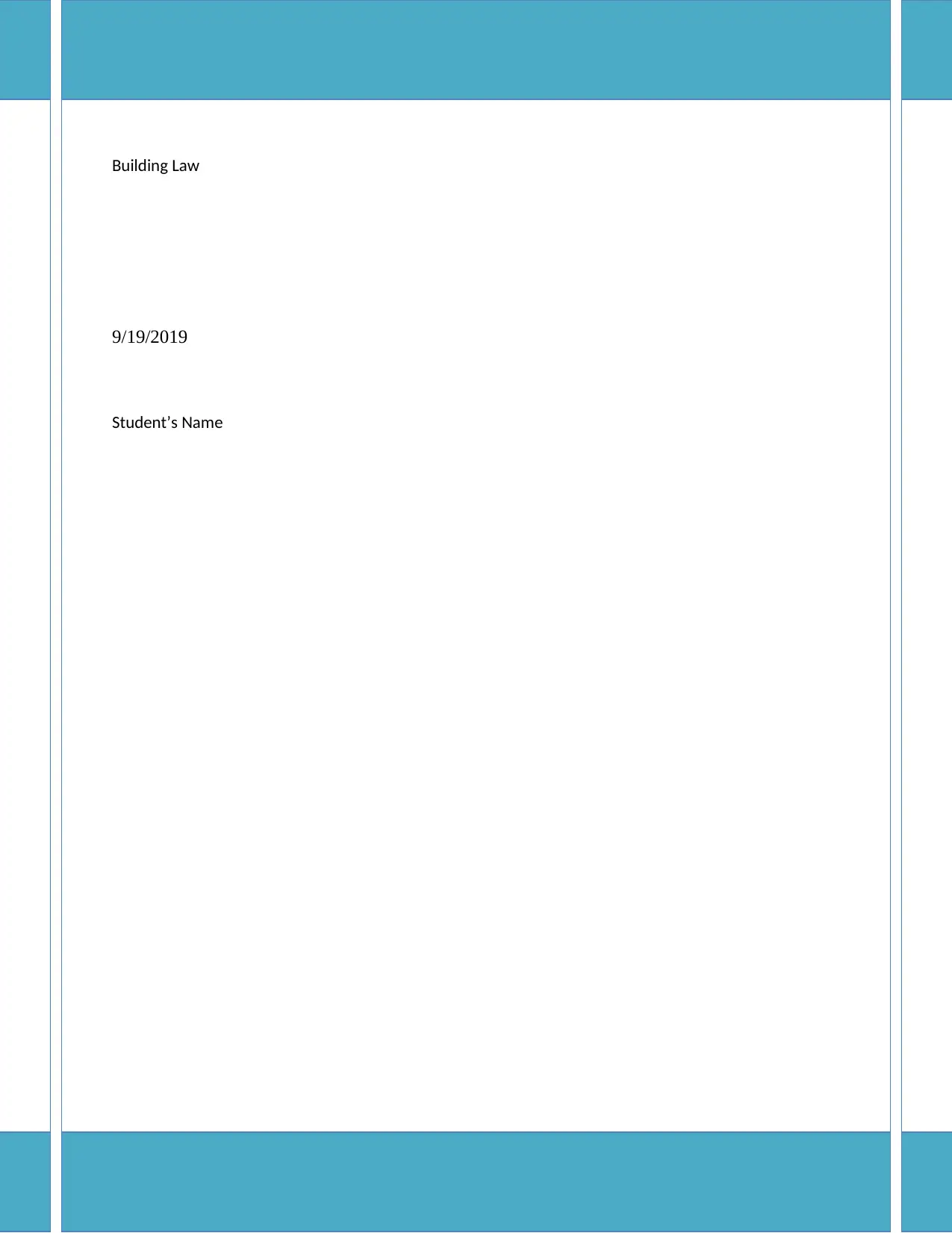
Building Law
9/19/2019
Student’s Name
9/19/2019
Student’s Name
Paraphrase This Document
Need a fresh take? Get an instant paraphrase of this document with our AI Paraphraser
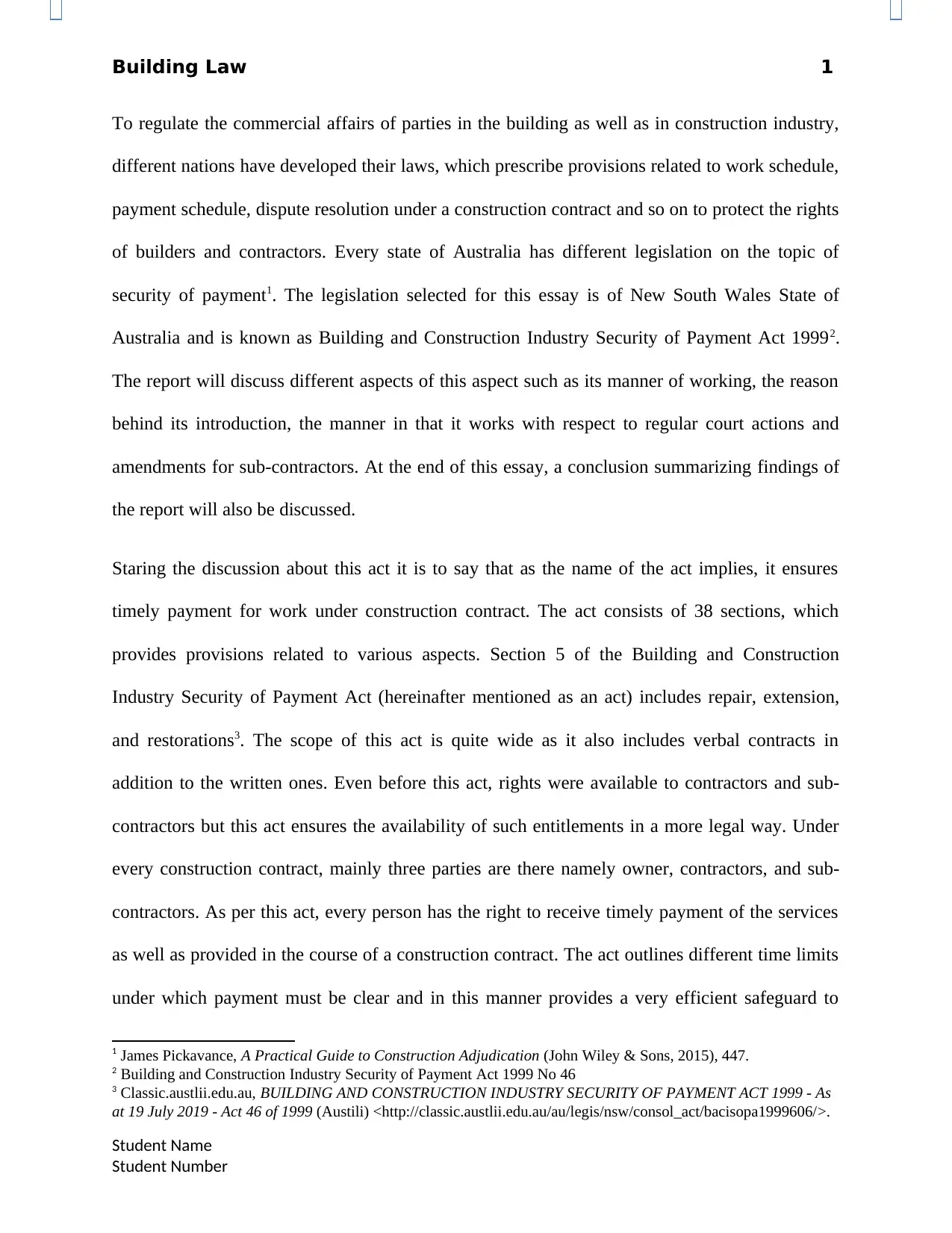
Building Law 1
To regulate the commercial affairs of parties in the building as well as in construction industry,
different nations have developed their laws, which prescribe provisions related to work schedule,
payment schedule, dispute resolution under a construction contract and so on to protect the rights
of builders and contractors. Every state of Australia has different legislation on the topic of
security of payment1. The legislation selected for this essay is of New South Wales State of
Australia and is known as Building and Construction Industry Security of Payment Act 19992.
The report will discuss different aspects of this aspect such as its manner of working, the reason
behind its introduction, the manner in that it works with respect to regular court actions and
amendments for sub-contractors. At the end of this essay, a conclusion summarizing findings of
the report will also be discussed.
Staring the discussion about this act it is to say that as the name of the act implies, it ensures
timely payment for work under construction contract. The act consists of 38 sections, which
provides provisions related to various aspects. Section 5 of the Building and Construction
Industry Security of Payment Act (hereinafter mentioned as an act) includes repair, extension,
and restorations3. The scope of this act is quite wide as it also includes verbal contracts in
addition to the written ones. Even before this act, rights were available to contractors and sub-
contractors but this act ensures the availability of such entitlements in a more legal way. Under
every construction contract, mainly three parties are there namely owner, contractors, and sub-
contractors. As per this act, every person has the right to receive timely payment of the services
as well as provided in the course of a construction contract. The act outlines different time limits
under which payment must be clear and in this manner provides a very efficient safeguard to
1 James Pickavance, A Practical Guide to Construction Adjudication (John Wiley & Sons, 2015), 447.
2 Building and Construction Industry Security of Payment Act 1999 No 46
3 Classic.austlii.edu.au, BUILDING AND CONSTRUCTION INDUSTRY SECURITY OF PAYMENT ACT 1999 - As
at 19 July 2019 - Act 46 of 1999 (Austili) <http://classic.austlii.edu.au/au/legis/nsw/consol_act/bacisopa1999606/>.
Student Name
Student Number
To regulate the commercial affairs of parties in the building as well as in construction industry,
different nations have developed their laws, which prescribe provisions related to work schedule,
payment schedule, dispute resolution under a construction contract and so on to protect the rights
of builders and contractors. Every state of Australia has different legislation on the topic of
security of payment1. The legislation selected for this essay is of New South Wales State of
Australia and is known as Building and Construction Industry Security of Payment Act 19992.
The report will discuss different aspects of this aspect such as its manner of working, the reason
behind its introduction, the manner in that it works with respect to regular court actions and
amendments for sub-contractors. At the end of this essay, a conclusion summarizing findings of
the report will also be discussed.
Staring the discussion about this act it is to say that as the name of the act implies, it ensures
timely payment for work under construction contract. The act consists of 38 sections, which
provides provisions related to various aspects. Section 5 of the Building and Construction
Industry Security of Payment Act (hereinafter mentioned as an act) includes repair, extension,
and restorations3. The scope of this act is quite wide as it also includes verbal contracts in
addition to the written ones. Even before this act, rights were available to contractors and sub-
contractors but this act ensures the availability of such entitlements in a more legal way. Under
every construction contract, mainly three parties are there namely owner, contractors, and sub-
contractors. As per this act, every person has the right to receive timely payment of the services
as well as provided in the course of a construction contract. The act outlines different time limits
under which payment must be clear and in this manner provides a very efficient safeguard to
1 James Pickavance, A Practical Guide to Construction Adjudication (John Wiley & Sons, 2015), 447.
2 Building and Construction Industry Security of Payment Act 1999 No 46
3 Classic.austlii.edu.au, BUILDING AND CONSTRUCTION INDUSTRY SECURITY OF PAYMENT ACT 1999 - As
at 19 July 2019 - Act 46 of 1999 (Austili) <http://classic.austlii.edu.au/au/legis/nsw/consol_act/bacisopa1999606/>.
Student Name
Student Number
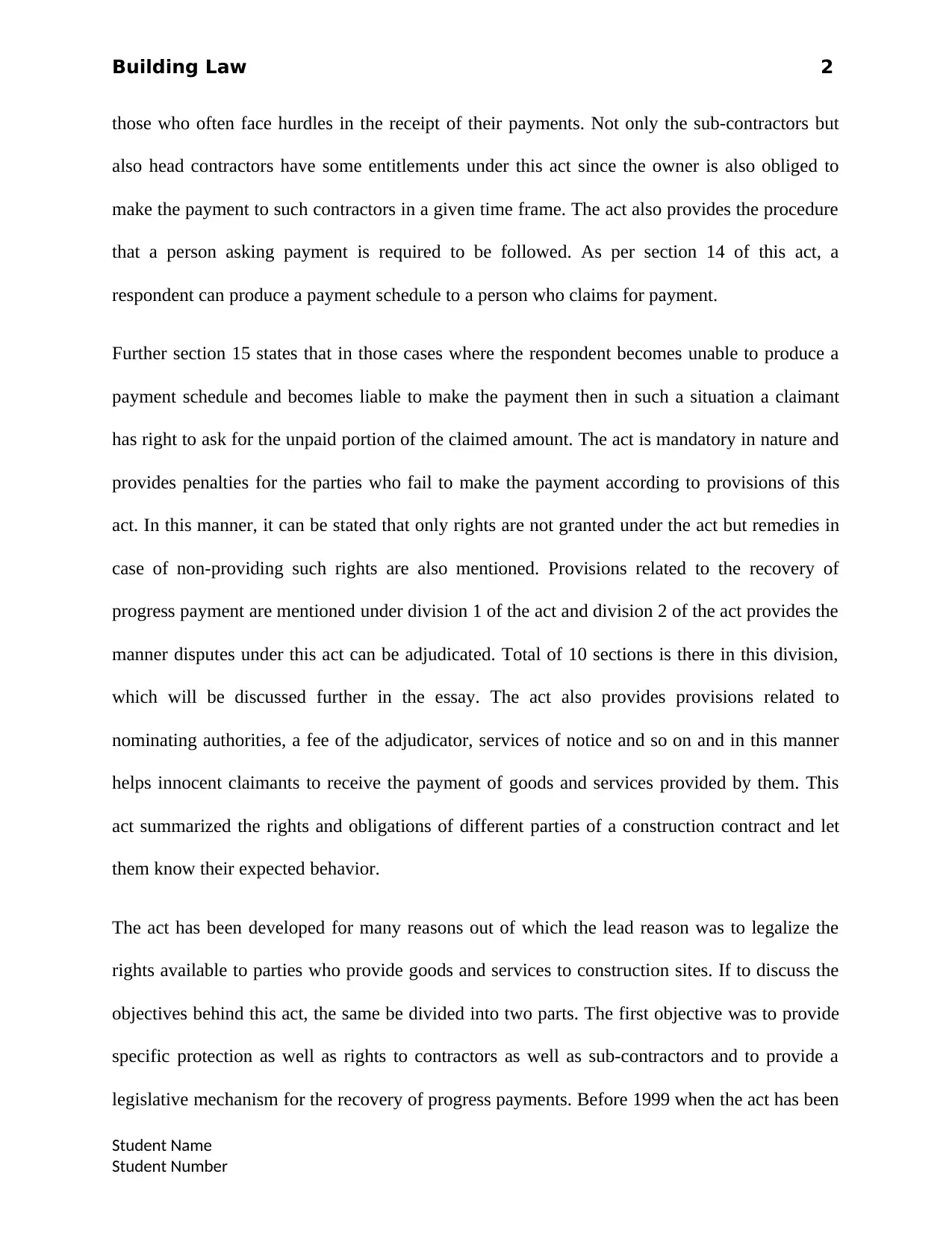
Building Law 2
those who often face hurdles in the receipt of their payments. Not only the sub-contractors but
also head contractors have some entitlements under this act since the owner is also obliged to
make the payment to such contractors in a given time frame. The act also provides the procedure
that a person asking payment is required to be followed. As per section 14 of this act, a
respondent can produce a payment schedule to a person who claims for payment.
Further section 15 states that in those cases where the respondent becomes unable to produce a
payment schedule and becomes liable to make the payment then in such a situation a claimant
has right to ask for the unpaid portion of the claimed amount. The act is mandatory in nature and
provides penalties for the parties who fail to make the payment according to provisions of this
act. In this manner, it can be stated that only rights are not granted under the act but remedies in
case of non-providing such rights are also mentioned. Provisions related to the recovery of
progress payment are mentioned under division 1 of the act and division 2 of the act provides the
manner disputes under this act can be adjudicated. Total of 10 sections is there in this division,
which will be discussed further in the essay. The act also provides provisions related to
nominating authorities, a fee of the adjudicator, services of notice and so on and in this manner
helps innocent claimants to receive the payment of goods and services provided by them. This
act summarized the rights and obligations of different parties of a construction contract and let
them know their expected behavior.
The act has been developed for many reasons out of which the lead reason was to legalize the
rights available to parties who provide goods and services to construction sites. If to discuss the
objectives behind this act, the same be divided into two parts. The first objective was to provide
specific protection as well as rights to contractors as well as sub-contractors and to provide a
legislative mechanism for the recovery of progress payments. Before 1999 when the act has been
Student Name
Student Number
those who often face hurdles in the receipt of their payments. Not only the sub-contractors but
also head contractors have some entitlements under this act since the owner is also obliged to
make the payment to such contractors in a given time frame. The act also provides the procedure
that a person asking payment is required to be followed. As per section 14 of this act, a
respondent can produce a payment schedule to a person who claims for payment.
Further section 15 states that in those cases where the respondent becomes unable to produce a
payment schedule and becomes liable to make the payment then in such a situation a claimant
has right to ask for the unpaid portion of the claimed amount. The act is mandatory in nature and
provides penalties for the parties who fail to make the payment according to provisions of this
act. In this manner, it can be stated that only rights are not granted under the act but remedies in
case of non-providing such rights are also mentioned. Provisions related to the recovery of
progress payment are mentioned under division 1 of the act and division 2 of the act provides the
manner disputes under this act can be adjudicated. Total of 10 sections is there in this division,
which will be discussed further in the essay. The act also provides provisions related to
nominating authorities, a fee of the adjudicator, services of notice and so on and in this manner
helps innocent claimants to receive the payment of goods and services provided by them. This
act summarized the rights and obligations of different parties of a construction contract and let
them know their expected behavior.
The act has been developed for many reasons out of which the lead reason was to legalize the
rights available to parties who provide goods and services to construction sites. If to discuss the
objectives behind this act, the same be divided into two parts. The first objective was to provide
specific protection as well as rights to contractors as well as sub-contractors and to provide a
legislative mechanism for the recovery of progress payments. Before 1999 when the act has been
Student Name
Student Number
⊘ This is a preview!⊘
Do you want full access?
Subscribe today to unlock all pages.

Trusted by 1+ million students worldwide
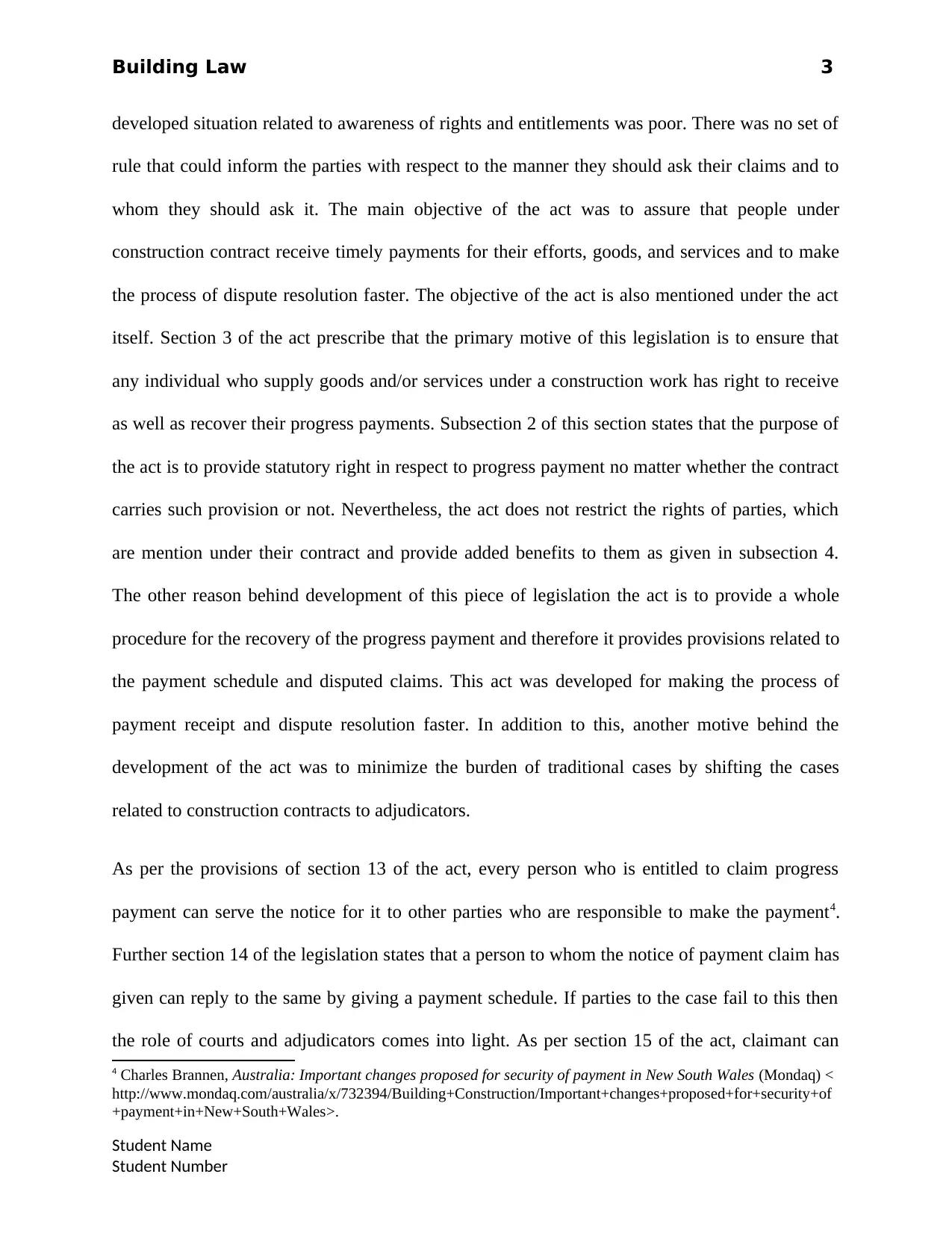
Building Law 3
developed situation related to awareness of rights and entitlements was poor. There was no set of
rule that could inform the parties with respect to the manner they should ask their claims and to
whom they should ask it. The main objective of the act was to assure that people under
construction contract receive timely payments for their efforts, goods, and services and to make
the process of dispute resolution faster. The objective of the act is also mentioned under the act
itself. Section 3 of the act prescribe that the primary motive of this legislation is to ensure that
any individual who supply goods and/or services under a construction work has right to receive
as well as recover their progress payments. Subsection 2 of this section states that the purpose of
the act is to provide statutory right in respect to progress payment no matter whether the contract
carries such provision or not. Nevertheless, the act does not restrict the rights of parties, which
are mention under their contract and provide added benefits to them as given in subsection 4.
The other reason behind development of this piece of legislation the act is to provide a whole
procedure for the recovery of the progress payment and therefore it provides provisions related to
the payment schedule and disputed claims. This act was developed for making the process of
payment receipt and dispute resolution faster. In addition to this, another motive behind the
development of the act was to minimize the burden of traditional cases by shifting the cases
related to construction contracts to adjudicators.
As per the provisions of section 13 of the act, every person who is entitled to claim progress
payment can serve the notice for it to other parties who are responsible to make the payment4.
Further section 14 of the legislation states that a person to whom the notice of payment claim has
given can reply to the same by giving a payment schedule. If parties to the case fail to this then
the role of courts and adjudicators comes into light. As per section 15 of the act, claimant can
4 Charles Brannen, Australia: Important changes proposed for security of payment in New South Wales (Mondaq) <
http://www.mondaq.com/australia/x/732394/Building+Construction/Important+changes+proposed+for+security+of
+payment+in+New+South+Wales>.
Student Name
Student Number
developed situation related to awareness of rights and entitlements was poor. There was no set of
rule that could inform the parties with respect to the manner they should ask their claims and to
whom they should ask it. The main objective of the act was to assure that people under
construction contract receive timely payments for their efforts, goods, and services and to make
the process of dispute resolution faster. The objective of the act is also mentioned under the act
itself. Section 3 of the act prescribe that the primary motive of this legislation is to ensure that
any individual who supply goods and/or services under a construction work has right to receive
as well as recover their progress payments. Subsection 2 of this section states that the purpose of
the act is to provide statutory right in respect to progress payment no matter whether the contract
carries such provision or not. Nevertheless, the act does not restrict the rights of parties, which
are mention under their contract and provide added benefits to them as given in subsection 4.
The other reason behind development of this piece of legislation the act is to provide a whole
procedure for the recovery of the progress payment and therefore it provides provisions related to
the payment schedule and disputed claims. This act was developed for making the process of
payment receipt and dispute resolution faster. In addition to this, another motive behind the
development of the act was to minimize the burden of traditional cases by shifting the cases
related to construction contracts to adjudicators.
As per the provisions of section 13 of the act, every person who is entitled to claim progress
payment can serve the notice for it to other parties who are responsible to make the payment4.
Further section 14 of the legislation states that a person to whom the notice of payment claim has
given can reply to the same by giving a payment schedule. If parties to the case fail to this then
the role of courts and adjudicators comes into light. As per section 15 of the act, claimant can
4 Charles Brannen, Australia: Important changes proposed for security of payment in New South Wales (Mondaq) <
http://www.mondaq.com/australia/x/732394/Building+Construction/Important+changes+proposed+for+security+of
+payment+in+New+South+Wales>.
Student Name
Student Number
Paraphrase This Document
Need a fresh take? Get an instant paraphrase of this document with our AI Paraphraser
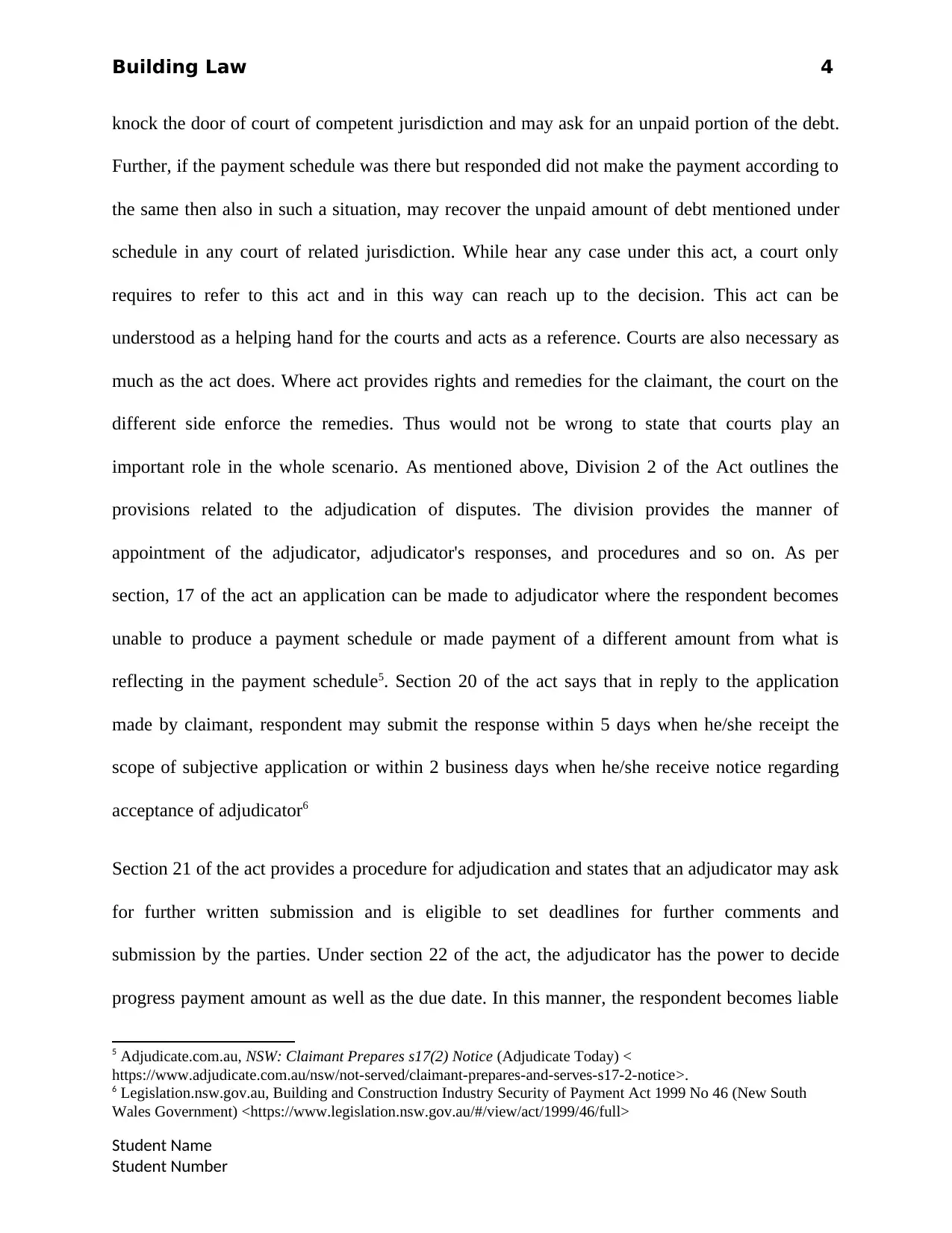
Building Law 4
knock the door of court of competent jurisdiction and may ask for an unpaid portion of the debt.
Further, if the payment schedule was there but responded did not make the payment according to
the same then also in such a situation, may recover the unpaid amount of debt mentioned under
schedule in any court of related jurisdiction. While hear any case under this act, a court only
requires to refer to this act and in this way can reach up to the decision. This act can be
understood as a helping hand for the courts and acts as a reference. Courts are also necessary as
much as the act does. Where act provides rights and remedies for the claimant, the court on the
different side enforce the remedies. Thus would not be wrong to state that courts play an
important role in the whole scenario. As mentioned above, Division 2 of the Act outlines the
provisions related to the adjudication of disputes. The division provides the manner of
appointment of the adjudicator, adjudicator's responses, and procedures and so on. As per
section, 17 of the act an application can be made to adjudicator where the respondent becomes
unable to produce a payment schedule or made payment of a different amount from what is
reflecting in the payment schedule5. Section 20 of the act says that in reply to the application
made by claimant, respondent may submit the response within 5 days when he/she receipt the
scope of subjective application or within 2 business days when he/she receive notice regarding
acceptance of adjudicator6
Section 21 of the act provides a procedure for adjudication and states that an adjudicator may ask
for further written submission and is eligible to set deadlines for further comments and
submission by the parties. Under section 22 of the act, the adjudicator has the power to decide
progress payment amount as well as the due date. In this manner, the respondent becomes liable
5 Adjudicate.com.au, NSW: Claimant Prepares s17(2) Notice (Adjudicate Today) <
https://www.adjudicate.com.au/nsw/not-served/claimant-prepares-and-serves-s17-2-notice>.
6 Legislation.nsw.gov.au, Building and Construction Industry Security of Payment Act 1999 No 46 (New South
Wales Government) <https://www.legislation.nsw.gov.au/#/view/act/1999/46/full>
Student Name
Student Number
knock the door of court of competent jurisdiction and may ask for an unpaid portion of the debt.
Further, if the payment schedule was there but responded did not make the payment according to
the same then also in such a situation, may recover the unpaid amount of debt mentioned under
schedule in any court of related jurisdiction. While hear any case under this act, a court only
requires to refer to this act and in this way can reach up to the decision. This act can be
understood as a helping hand for the courts and acts as a reference. Courts are also necessary as
much as the act does. Where act provides rights and remedies for the claimant, the court on the
different side enforce the remedies. Thus would not be wrong to state that courts play an
important role in the whole scenario. As mentioned above, Division 2 of the Act outlines the
provisions related to the adjudication of disputes. The division provides the manner of
appointment of the adjudicator, adjudicator's responses, and procedures and so on. As per
section, 17 of the act an application can be made to adjudicator where the respondent becomes
unable to produce a payment schedule or made payment of a different amount from what is
reflecting in the payment schedule5. Section 20 of the act says that in reply to the application
made by claimant, respondent may submit the response within 5 days when he/she receipt the
scope of subjective application or within 2 business days when he/she receive notice regarding
acceptance of adjudicator6
Section 21 of the act provides a procedure for adjudication and states that an adjudicator may ask
for further written submission and is eligible to set deadlines for further comments and
submission by the parties. Under section 22 of the act, the adjudicator has the power to decide
progress payment amount as well as the due date. In this manner, the respondent becomes liable
5 Adjudicate.com.au, NSW: Claimant Prepares s17(2) Notice (Adjudicate Today) <
https://www.adjudicate.com.au/nsw/not-served/claimant-prepares-and-serves-s17-2-notice>.
6 Legislation.nsw.gov.au, Building and Construction Industry Security of Payment Act 1999 No 46 (New South
Wales Government) <https://www.legislation.nsw.gov.au/#/view/act/1999/46/full>
Student Name
Student Number
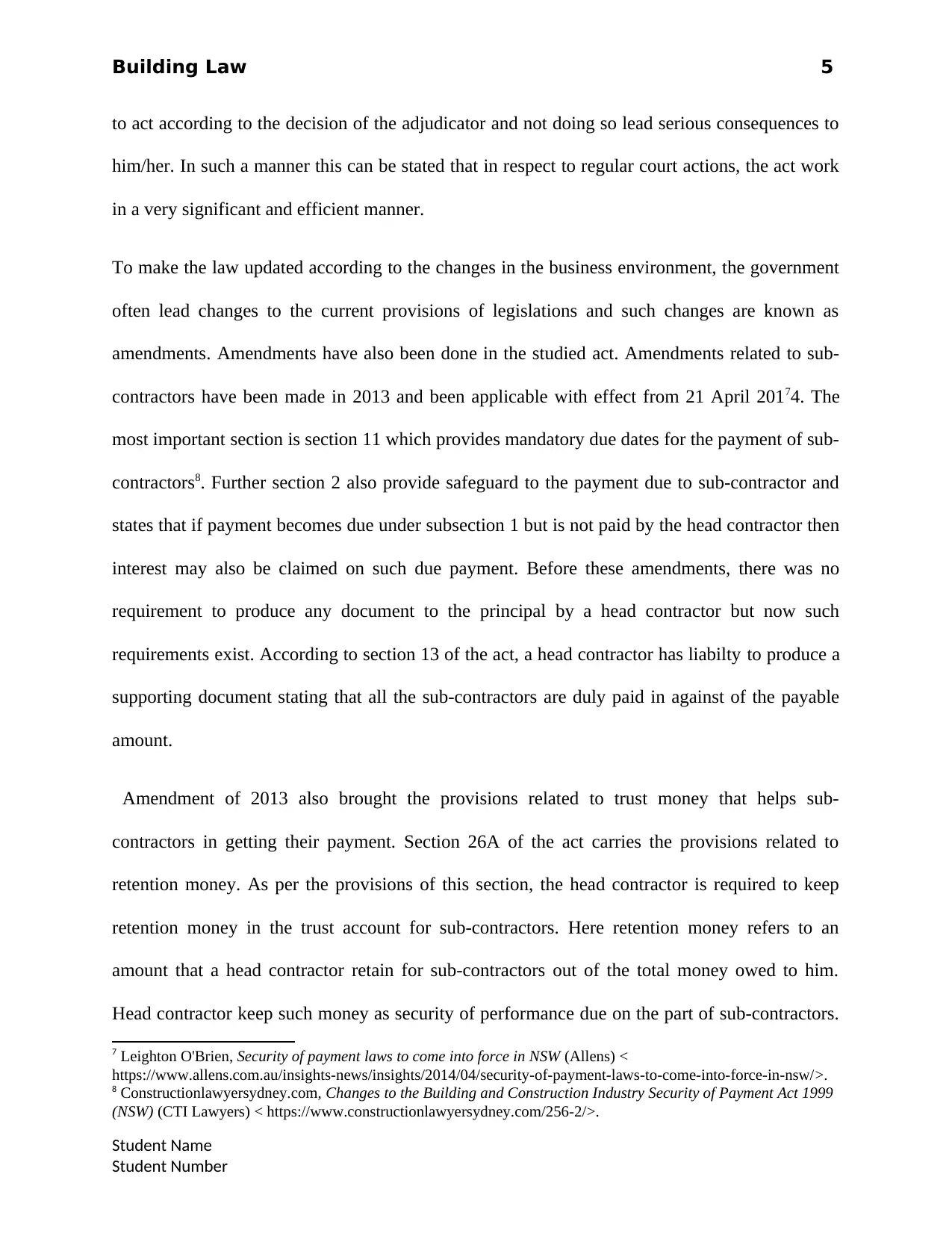
Building Law 5
to act according to the decision of the adjudicator and not doing so lead serious consequences to
him/her. In such a manner this can be stated that in respect to regular court actions, the act work
in a very significant and efficient manner.
To make the law updated according to the changes in the business environment, the government
often lead changes to the current provisions of legislations and such changes are known as
amendments. Amendments have also been done in the studied act. Amendments related to sub-
contractors have been made in 2013 and been applicable with effect from 21 April 20174. The
most important section is section 11 which provides mandatory due dates for the payment of sub-
contractors8. Further section 2 also provide safeguard to the payment due to sub-contractor and
states that if payment becomes due under subsection 1 but is not paid by the head contractor then
interest may also be claimed on such due payment. Before these amendments, there was no
requirement to produce any document to the principal by a head contractor but now such
requirements exist. According to section 13 of the act, a head contractor has liabilty to produce a
supporting document stating that all the sub-contractors are duly paid in against of the payable
amount.
Amendment of 2013 also brought the provisions related to trust money that helps sub-
contractors in getting their payment. Section 26A of the act carries the provisions related to
retention money. As per the provisions of this section, the head contractor is required to keep
retention money in the trust account for sub-contractors. Here retention money refers to an
amount that a head contractor retain for sub-contractors out of the total money owed to him.
Head contractor keep such money as security of performance due on the part of sub-contractors.
7 Leighton O'Brien, Security of payment laws to come into force in NSW (Allens) <
https://www.allens.com.au/insights-news/insights/2014/04/security-of-payment-laws-to-come-into-force-in-nsw/>.
8 Constructionlawyersydney.com, Changes to the Building and Construction Industry Security of Payment Act 1999
(NSW) (CTI Lawyers) < https://www.constructionlawyersydney.com/256-2/>.
Student Name
Student Number
to act according to the decision of the adjudicator and not doing so lead serious consequences to
him/her. In such a manner this can be stated that in respect to regular court actions, the act work
in a very significant and efficient manner.
To make the law updated according to the changes in the business environment, the government
often lead changes to the current provisions of legislations and such changes are known as
amendments. Amendments have also been done in the studied act. Amendments related to sub-
contractors have been made in 2013 and been applicable with effect from 21 April 20174. The
most important section is section 11 which provides mandatory due dates for the payment of sub-
contractors8. Further section 2 also provide safeguard to the payment due to sub-contractor and
states that if payment becomes due under subsection 1 but is not paid by the head contractor then
interest may also be claimed on such due payment. Before these amendments, there was no
requirement to produce any document to the principal by a head contractor but now such
requirements exist. According to section 13 of the act, a head contractor has liabilty to produce a
supporting document stating that all the sub-contractors are duly paid in against of the payable
amount.
Amendment of 2013 also brought the provisions related to trust money that helps sub-
contractors in getting their payment. Section 26A of the act carries the provisions related to
retention money. As per the provisions of this section, the head contractor is required to keep
retention money in the trust account for sub-contractors. Here retention money refers to an
amount that a head contractor retain for sub-contractors out of the total money owed to him.
Head contractor keep such money as security of performance due on the part of sub-contractors.
7 Leighton O'Brien, Security of payment laws to come into force in NSW (Allens) <
https://www.allens.com.au/insights-news/insights/2014/04/security-of-payment-laws-to-come-into-force-in-nsw/>.
8 Constructionlawyersydney.com, Changes to the Building and Construction Industry Security of Payment Act 1999
(NSW) (CTI Lawyers) < https://www.constructionlawyersydney.com/256-2/>.
Student Name
Student Number
⊘ This is a preview!⊘
Do you want full access?
Subscribe today to unlock all pages.

Trusted by 1+ million students worldwide
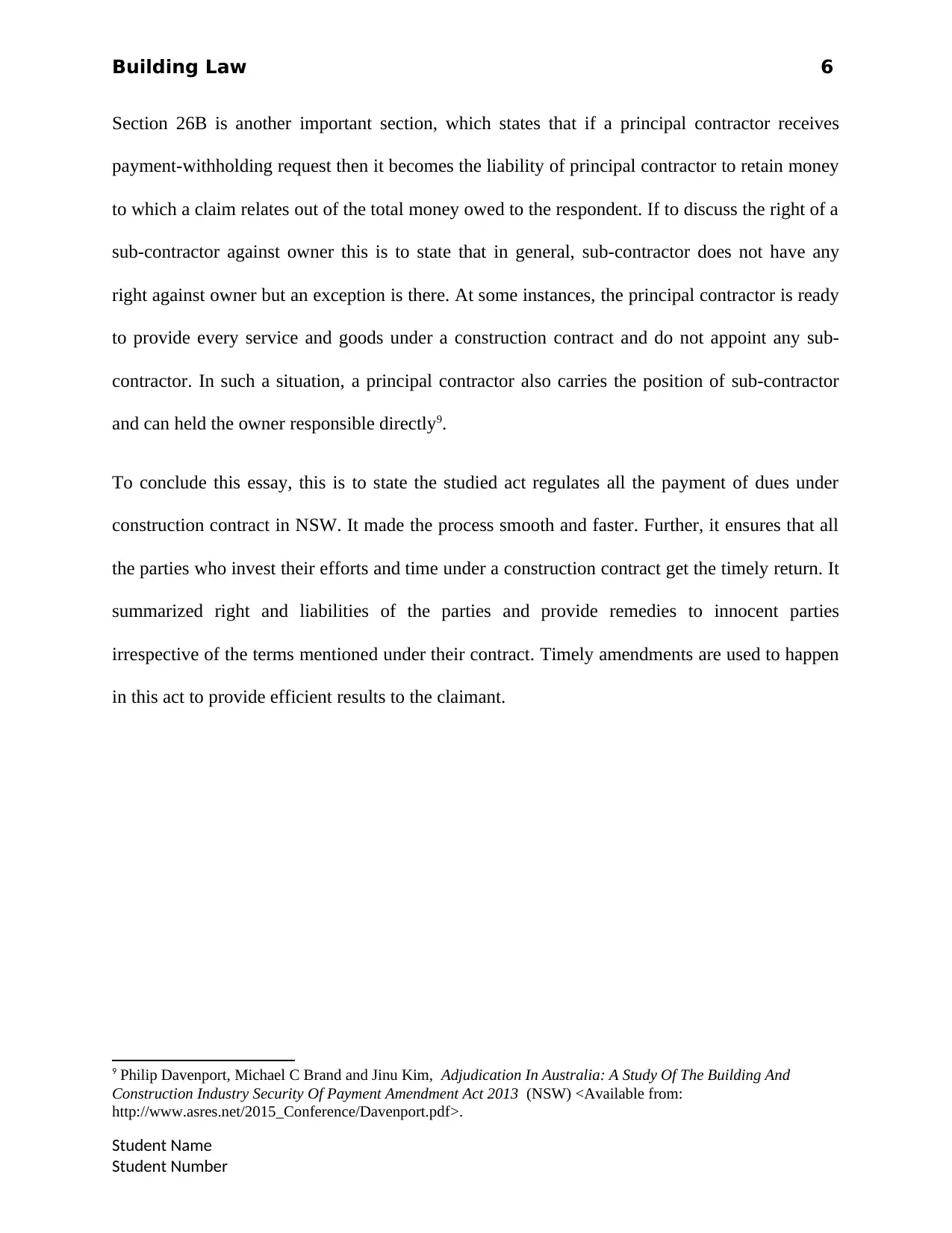
Building Law 6
Section 26B is another important section, which states that if a principal contractor receives
payment-withholding request then it becomes the liability of principal contractor to retain money
to which a claim relates out of the total money owed to the respondent. If to discuss the right of a
sub-contractor against owner this is to state that in general, sub-contractor does not have any
right against owner but an exception is there. At some instances, the principal contractor is ready
to provide every service and goods under a construction contract and do not appoint any sub-
contractor. In such a situation, a principal contractor also carries the position of sub-contractor
and can held the owner responsible directly9.
To conclude this essay, this is to state the studied act regulates all the payment of dues under
construction contract in NSW. It made the process smooth and faster. Further, it ensures that all
the parties who invest their efforts and time under a construction contract get the timely return. It
summarized right and liabilities of the parties and provide remedies to innocent parties
irrespective of the terms mentioned under their contract. Timely amendments are used to happen
in this act to provide efficient results to the claimant.
9 Philip Davenport, Michael C Brand and Jinu Kim, Adjudication In Australia: A Study Of The Building And
Construction Industry Security Of Payment Amendment Act 2013 (NSW) <Available from:
http://www.asres.net/2015_Conference/Davenport.pdf>.
Student Name
Student Number
Section 26B is another important section, which states that if a principal contractor receives
payment-withholding request then it becomes the liability of principal contractor to retain money
to which a claim relates out of the total money owed to the respondent. If to discuss the right of a
sub-contractor against owner this is to state that in general, sub-contractor does not have any
right against owner but an exception is there. At some instances, the principal contractor is ready
to provide every service and goods under a construction contract and do not appoint any sub-
contractor. In such a situation, a principal contractor also carries the position of sub-contractor
and can held the owner responsible directly9.
To conclude this essay, this is to state the studied act regulates all the payment of dues under
construction contract in NSW. It made the process smooth and faster. Further, it ensures that all
the parties who invest their efforts and time under a construction contract get the timely return. It
summarized right and liabilities of the parties and provide remedies to innocent parties
irrespective of the terms mentioned under their contract. Timely amendments are used to happen
in this act to provide efficient results to the claimant.
9 Philip Davenport, Michael C Brand and Jinu Kim, Adjudication In Australia: A Study Of The Building And
Construction Industry Security Of Payment Amendment Act 2013 (NSW) <Available from:
http://www.asres.net/2015_Conference/Davenport.pdf>.
Student Name
Student Number
1 out of 7
Related Documents
Your All-in-One AI-Powered Toolkit for Academic Success.
+13062052269
info@desklib.com
Available 24*7 on WhatsApp / Email
![[object Object]](/_next/static/media/star-bottom.7253800d.svg)
Unlock your academic potential
Copyright © 2020–2025 A2Z Services. All Rights Reserved. Developed and managed by ZUCOL.



